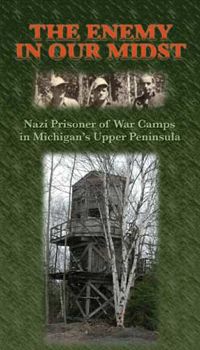Posted by Scott on July 14, 2010 at 8 a.m.
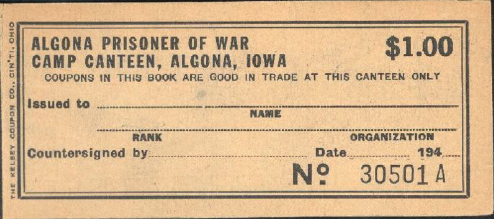
|
|
traces.org
|
Traces assembled some interesting facts on money at Camp Algona.
From Lt. Col. Arthur T. Lobdell, Commandant:
The P.W. was never paid in money but he was paid in coupons, which they could spend in their canteen for such items as: newspapers, books, soap, haircuts and other non-rationed items. At first they spent all of their earnings, but toward the spring of 1945 they began saving and when they left Algona in the winter of 1946 each averaged about $135.00 of savings to take to Germany.
Some details:
-
chits instead of coins: 1¢, 5¢, 10¢, 25¢, 50¢
-
$805,000 in chits printed
-
coupon booklets: $1, $3, $5, and $10
-
printed by Kelsey Coupon Company in Cincinnati, OH
There's lots more in the slide show by Steve Feller: Scrip of the PW Camp at Algona, IA. (Flash required)
Posted by Scott on June 23, 2010 at 8 a.m.

|
|
None
|
In case you didn't click through to read the entire Encyclopedia of Alabama article yesterday, here's more:
Each major camp established camp colleges, and prisoners could enroll in a wide variety of courses, including history, mathematics, the sciences, vocational courses, and preparatory classes for students seeking postwar careers in medicine, law, electrical engineering, and architecture. The educational opportunities provided by these camp colleges proved popular. For example, of Camp Opelika's 3,000 prisoners, some 1,400 participated in coursework. Initially, prisoners taught the courses. Later, prisoners were permitted to enroll in correspondence courses from the University of Michigan and the University of Wisconsin.
There are similar stories from camps across the US and Canada.
Posted by Scott on June 22, 2010 at 8 a.m.
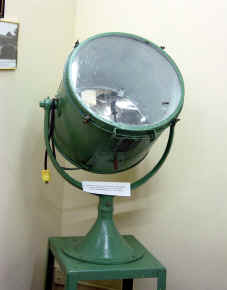
|
|
eastalabama.org/pow_camp.htm
|
The Museum of East Alabama includes an exhibit on Camp Opelika:
Interesting camp equipment, such as the guard tower spotlight ... and the last remaining barracks building
The Encyclopedia of Alabama has a great article on POW camps in the state:
During World War II, the state of Alabama was home to approximately 16,000 German prisoners of war (POWs) in 24 camps.
...
The Army Corps of Engineers constructed Alabama's first camps during the winter of 1942-1943. Army doctrine dictated that camps be built either at existing military bases or at sites distant from major cities and industrial centers, and military surveyors toured the state for suitable locations.
...
Camp Opelika was capable of housing 3,000 POWs
(There's lots more in the article.)
Posted by Scott on June 16, 2010 at 8 a.m.
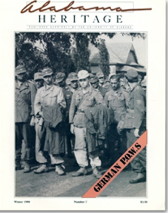
|
|
alabamaheritage.com
|
The Alabama Heritage magazine has an online reprint of "Inside the Wire: Aliceville and the Afrika Korps" by Randy Wall.
A classic opening:
The slow-turning fans above the soda fountain at Jones’ Drugstore in Aliceville brought scant relief from the sultry heat. It was August of 1942 and the Corps had arrived—the U.S. Army Corps of Engineers. Everyone had seen them, with their tripods and transits, squinting down imaginary lines over on Doc Parker’s land, near the dairy now operated by the doctor’s son, Tom. The crowd at the drugstore argued endlessly about the significance of the Corps’ presence.
The camps offered real benefits to local communities:
the impact of the construction payroll on the community was immense. Up to $75,000 per week was pumped into the Aliceville economy, area rooming houses were filled to capacity, and in the weeks before Christmas the town experienced nearly total employment.
POWs arrive:
For most of the new arrivals, food had been limited throughout their duty in North Africa, and conditions had grown worse after their capture. There had never been enough food at the mass internment camps, and the situation had improved only slightly on the crowded ocean voyage to the United States. Most of the men were severely malnourished, a fact reported to Colonel Prince, who quickly made the decision to open the mess halls that night.
That was no simple task, yet by 2 A.M. the initial group of prisoners sat down to their first substantial meal in months. If the last nine hours had bewildered the German POWs, this they understood—food. Food in abundance—meat, eggs, vegetables, coffee—even a strange, sticky concoction that appeared to be made from mashed peanuts. After months in the desert living on military rations, the sights and smells in the mess halls that morning were almost beyond comprehension for the new arrivals.
There's lots more in the article, including several interesting sidebars.
Posted by Kim on June 09, 2010 at 8 a.m.
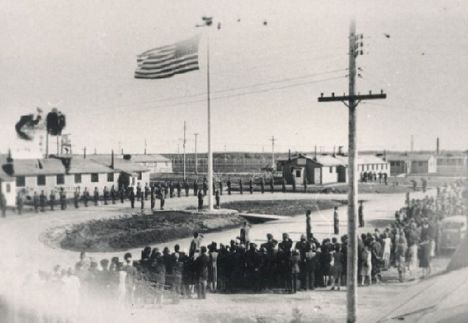
|
|
traces.org
|
TRACES (covered before) has 2 slideshows of the Algona, IA POW camp.
Posted by Kim on June 08, 2010 at 8 a.m.
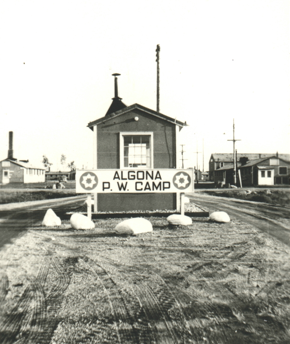
|
|
pwcamp.algona.org
|
During WWII, a Camp in Algona, IA housed 10,000 German POWs. In 2004, the town opened a German POW museum with four exhibits.
According to the museum's website:
Many residents and vistors remark that they had no idea such a camp existed, so the Camp Algona POW Museum seeks to inform and educate visitors about this important time in history, both for Algona and the world at large.
Their website includes many interesting photos and stories.
For instance:
Posted by Kim on June 03, 2010 at 8 a.m.
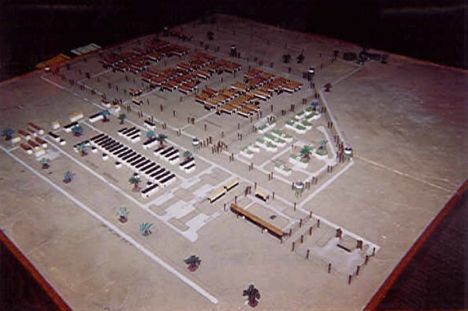
|
|
camphearne.info
|
Camp Hearne was part of the video we covered yesterday.
A detailed model of the camp (pictured above) is on display at the Hearne Chamber of Commerce. Their site notes:
A replica of one of the barracks, which is being built from original floor plans, is almost complete. It will house a new on-site visitors center.
Progress on the project is being updated regularly on a blog.
The Friends of Camp Hearne have useful information, including lesson plans for teachers.
The PBS show History Detectives covered the camp in 2005. We could not find a video clip, but here's a transcript (PDF) of the episode.
Michael R. Waters and his students put together some historical info.
William Kent Brunette maintains an extensive set of links.
Posted by Kim on June 02, 2010 at 8 a.m.
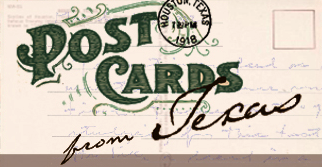
|
|
http://www.houstons55.com/postcards-from-texas/
|
In March, Houston's Channel 55 aired "POW Camps in Texas" as part of their "Postcards from Texas" series.
Featured in the episode:
-
Mike Waters, author of Lone Star Stalag
-
Heino Erichsen, former POW at Camp Hearne
The video was posted in 2 parts:
Posted by Kim on June 01, 2010 at 8 a.m.

|
|
clker.com
|
In 1973, Robert Warren Tissing, Jr. completed his Baylor University Master's Thesis: "Utilization of Prisoners of War in the United States during World War II: Texas, A Case Study".
It's available online courtesy of the Robertson County Historical Commission.
From the conclusion:
The availability of prisoners for farm labor enabled farmers to save time and money by planting more crops and harvesting them faster. The German prisoners of war were well-treated during their stay in Texas. Almost all of the farmers enjoyed being around the prisoners and described them as being most cooperative and well-mannered. Many of the prisoners wrote letters to the farmers and expressed their desire to return to Texas.
Posted by Kim on May 07, 2010 at 8 a.m.
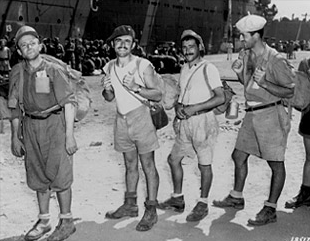
|
|
http://www.prisonersinparadise.com/
|
In addition to German POWs, the U.S. held about 51,000 Italian POWs during WW2.
Some are covered in an award winning documentary film. According to the film's website:
Featuring rare period footage of POW camps, "Prisoners in Paradise" follows six Italian POWs (and the women they met in America) on their extraordinary journey—full of challenges, love, perseverance, and good luck. Captured primarily in Northern Africa—where they had been surviving on hard biscuits and water—the Italian POW’s were uniformly amazed at the abundance of food in the USA and the generosity of their captors.
Interesting to note:
Shortly after the bulk of the Italian POW’s arrived, Italy officially switched sides in the war, and over ninety percent of the POWs agreed to collaborate with the Allied war effort.
The site includes a clip (4:54) from the film.
Posted by Kim on April 30, 2010 at 8 a.m.
WMNU-TV in Michigan has posted a viewer's guide (PDF) for the 2004 award winning documentary called "The Enemy in Our Midst: Nazi Prisoner of War Camps in Michigan's Upper Peninsula."
They also offer a booklet called POW Camps in the U.P. (PDF), which contains original articles cited in the documentary.
According to their site:
From 1944 to 1946, the German prisoners called five POW camps in the Upper Peninsula home: Camps AuTrain and Evelyn in Alger County, Camp Raco in Chippewa County and Camps Sidnaw and Pori in Houghton County. Brought in under a cloak of secrecy by the U.S. Army, the prisoners eventually encountered local residents, who were reluctant to accept the POWs.
and
The project, which took two years to complete, contains many scenes shot throughout the Upper Peninsula. Also included in the 161-minute documentary are hundreds of historic photos, vintage film and interviews with local residents who had encounters with the POWs.
Posted by Kim on April 21, 2010 at 8 a.m.
The November 2007 issue of World War II Magazine featured the Christmas Eve escape of 25 German POWs from a camp in Arizona during WWII.
According to the article:
Nearly 400,000 German POWs were brought to the United States during World War II, and officials recorded precisely 2,222 individual attempts by the Germans to flee their camps...
But none of these assorted breakouts could match in audacity, scale, or drama the plan under way at Compound 1A at Papago Park. It would trigger the largest manhunt in Arizona history, bringing in local law enforcement, the FBI, and even Papago Indian scouts.
Their "not so great escape" title seems unfair, but here's a taste of what the author may have had in mind:
While he was still on that call, another phone rang. It was the sheriff in Phoenix reporting he had an escaped POW in custody. Herbert Fuchs, a twenty-two-year-old U-boat crewman, had quickly grown tired of being wet, cold, and hungry and hitchhiked a ride to the sheriff's office. Soon thereafter, a Tempe woman called to say that two escapees had knocked on her door and surrendered; the phone rang again, and a Tempe man reported that two hungry and cold POWs had turned themselves in to him.
It took over a month to re-capture all of the escaped POWs, but all were eventually returned to camp.
Author: Ronald H. Bailey
Publication: World War II Magazine
Length: 3,959 words
Date: November 2007
Posted by Kim on April 15, 2010 at 8 a.m.

|
|
Traces.org
|
In addition to their very cool Bus-eum, TRACES has a Web site filled with interesting facts and stories about the POWs.
Their page called Encounters between Midwesterners and German or Austrian POWs includes many first-hand accounts from Americans.
For instance, this from a man named Jim Fitzgerald:
I remember as a nine year old walking home from the fourth grade we would pass the E.G. Morse Poultry house in Mason City, Iowa and see the POWs working, loading trucks and the like. We thought they were monsters until we started waving at them and they waved back, which started a relationship that has lasted till this day.
Here's one from Marjorie Myers Douglas:
I spread a faded blue tea towel over the loaves where the sunshine would help them rise, and I listened in growing bewilderment to his conversation.
“Am I talking to the officer in charge?” he asked. “Can you send me twenty of the prisoners tomorrow to stack hay bales—probably two days’ work? I’ll pay four dollars per man. By eight o’clock? And you’ll send a guard? And their food also? Sounds okay to me—tomorrow then.”
“What in the world? What prisoners?” I gasped as soon as he put the phone down.
“The mailman gave me the idea,” Don gloated. “Can you believe it? There are German prisoners of war in a temporary camp at Ortonville—just twenty miles away. We didn’t see it the day I drove you over there to Big Stone Lake. I’d never even heard of it. But they hire out the men to farms around here. I plan to get Bill Ahrens over to interpret. I’ll put a skid on the other tractor. Twenty prisoners as farm hands! We’re all set.”
Original source: Eggs in the Coffee Sheep in the Corn: My 17 Years as a Farmwife (1994).
Posted by Kim on April 13, 2010 at 8 a.m.
We came across a bilingual website that documents the history of WWII German POWs all around the world.
There is a page for Canada which mentions escape attempts:
600 prisoners tried to escape...in 1947 still 17 [were] not recaptured. 2 were alleged drowned, 1 in the U.S.A., 1 in Mexico and the rest still in Canada.
and a page for the USA which includes a quote about escapes:
Provost Marshal General noticed: "1369 escape attempts were made until March 1st, 1945 but only 12 prisoners of war (6 Germans and 6 Italians) were in liberty to this day."
More details:
Posted by Kim on April 09, 2010 at 8 a.m.
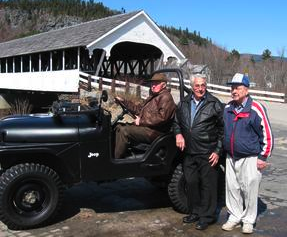
|
|
Photo credit: Allen Coop
|
The Coos County Democrat featured a small reunion that took place recently at a WW2 POW camp located in Stark, NH.
According to the article:
two former camp workers and one German ex-prisoner-of-war returned to the site to reflect on their time spent in Camp Stark during World War II, and the unlikely friendships that formed amongst the soldiers, civilians, and POWs on both sides of the fence.
Author: Kayti Burt
Publication: Coos County Democrat
Length: 1,148 words
Date: March 31, 2010
Posted by Kim on March 01, 2010 at 11:09 a.m.
(We'll start more active blogging soon. Meanwhile, here's a timely item that we came across.)
Historian Allen Koop, author of Stark Decency: German POWs in a New England Village, will be telling the story of New Hampshire's only World War II prisoner of war camp this week in Norwich, VT.
The event is part of the Vermont Humanities Council's Humanities Lecture Series called First Wednesdays.
According to the Norwich Public Library's website:
[Koop] describes how ordinary people in Stark turned bitter division into camaraderie.
title: Stark Decency: German POWs in a New England Village
speaker: Allen Koop
where: Norwich, VT
location: Norwich Congregational Church, 15 Church Street
date: Wednesday March 3, 2010
time: 7:00pm
cost: Free!
notes: Open to the public. For more information, call 802-649-1184.
(Update: changed the post title.)
| |
|











